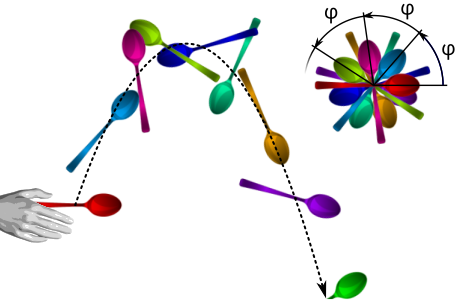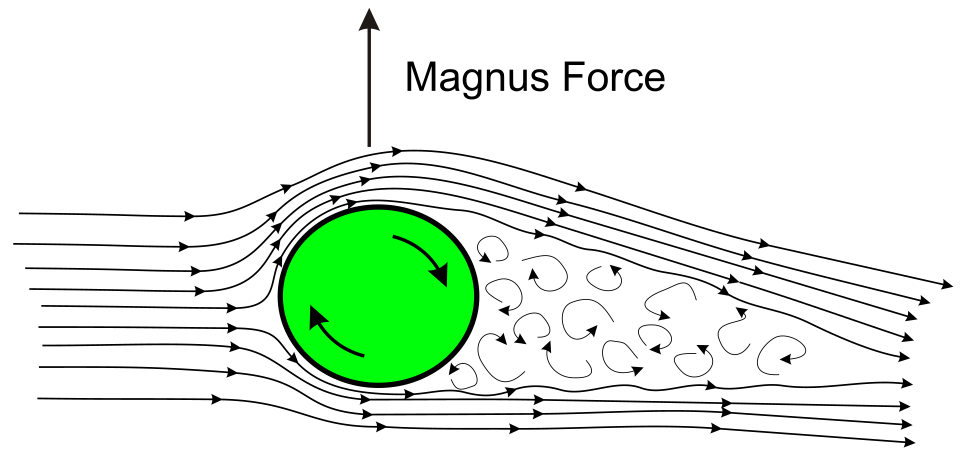OCR Specification focus:
‘State modelling assumptions: negligible air resistance, uniform g, point mass; discuss limitations in real situations.’
Projectile motion modelling simplifies complex real-world motion into an idealised framework. By assuming constant acceleration vertically and uniform velocity horizontally, students can predict and analyse trajectories mathematically and conceptually.
The Nature of Modelling in Projectile Motion
A model in physics is a simplified representation of a real system used to understand and predict physical behaviour. In projectile motion, the simplified two-dimensional model allows physicists to calculate position, velocity, and time using mathematical relationships derived from Newton’s laws. The accuracy of predictions depends on how closely real motion follows the assumptions within the model.
Modelling assumes that horizontal and vertical components of motion are independent, allowing separate analysis of each direction. In practice, this separation is only valid when external influences such as air resistance are negligible.
Core Assumptions of the Projectile Model
Negligible Air Resistance
The model assumes air resistance is negligible, meaning the projectile experiences no drag force opposing its motion.
Air Resistance: The resistive force exerted by air on an object moving through it, opposing its velocity and depending on shape, speed, and air density.
By neglecting this force, the projectile maintains a constant horizontal velocity, as no horizontal forces act upon it after launch. Vertically, the only force considered is weight, producing a constant acceleration due to gravity. This assumption holds reasonably well for small, dense objects moving at moderate speeds, such as metal spheres in laboratory conditions.
However, in real-world contexts such as ballistics or sports, air resistance significantly alters the trajectory:
The range is reduced because drag slows horizontal motion.
The maximum height and time of flight are shortened.
The path becomes less symmetrical — the descent is steeper than the ascent.
These deviations show that the ideal trajectory is parabolic, while the real trajectory is non-parabolic due to air drag.

Plot showing two trajectories for equal launch conditions: the ideal parabola without drag and the shorter, steeper path with air drag. The figure highlights reduced range and asymmetry introduced by resistive forces. Extra parameters shown in the description reflect the author’s numerical model but are not required by the OCR syllabus. Source.
Uniform Gravitational Field (Constant g)
Another key assumption is that gravitational acceleration (g) is uniform — constant in both magnitude and direction throughout the projectile’s flight.
Gravitational Field Strength (g): The force per unit mass experienced by an object in a gravitational field; near Earth’s surface it is approximately 9.81 m s⁻² directed downwards.
In reality, g varies slightly with altitude, latitude, and local geological conditions. For short trajectories near Earth’s surface, these variations are minimal and can be ignored. However, for long-range missiles, spacecraft launches, or motion at high altitudes, g decreases measurably with height, and the assumption of uniform gravity becomes invalid.
Under uniform g, vertical motion can be treated using the SUVAT equations for constant acceleration. These equations simplify the prediction of displacement, velocity, and time, provided the vertical acceleration remains constant.
Point Mass Approximation
The model treats the projectile as a point mass — an object with mass but no size, rotation, or surface features.
Point Mass: An idealised object whose entire mass is concentrated at a single point, ignoring rotational and surface effects.
This simplification removes the complexity of analysing rotational motion, aerodynamic lift, and torque. The assumption is appropriate for small, compact projectiles such as metal spheres or pellets. In contrast, real objects like footballs, arrows, or shuttlecocks rotate, experience drag, and may even generate lift due to their shape and spin.
Ignoring size and shape also means that the centre of mass is assumed to follow the calculated trajectory exactly, even though in reality spin and air flow can shift the motion path slightly.

Strobe sequence of a rotating object; the marked COM travels on a smooth parabolic path while the object spins about it. This neatly justifies the point-mass approximation used in basic projectile models. The strobe lab setup is more detailed than required, but the only essential takeaway is the COM’s parabolic path. Source.
Limitations of the Model in Real Situations
Non-Uniform Air Resistance
Air resistance depends on several factors:
Speed: Drag increases approximately with the square of velocity.
Surface area and shape: Streamlined objects experience less resistance.
Air density: Changes with temperature, pressure, and altitude.
Because these variables fluctuate, real projectiles often deviate significantly from ideal predictions. The model cannot account for terminal velocity, where drag balances weight, or for turbulent flow effects at high speeds.
Rotational and Magnus Effects
When a spinning object moves through air, pressure differences form around its surface, creating lift or sideways forces. This Magnus effect causes curved trajectories — for example, in a spinning football or tennis ball.

Diagram of a rotating body in airflow with deflected streamlines, pressure imbalance, and a lift force perpendicular to the flow. It explains why spin makes a projectile curve, a limitation excluded by the point-mass model. The cylinder idealisation is slightly more general than a ball but remains pedagogically appropriate. Source.
The standard projectile model, which assumes a point mass with no spin, completely omits these effects.
Atmospheric Variation and Wind
The model presumes still air with no horizontal wind. In real environments:
Wind velocity alters the horizontal component of motion.
Temperature gradients and air turbulence produce unpredictable deviations.
Thus, experimental projectile motion often requires repeated trials to estimate an average path.
Large-Scale or High-Altitude Motion
For large-scale trajectories, such as artillery shells or satellites:
Earth’s curvature becomes relevant, invalidating the assumption of a flat Earth surface.
Gravitational acceleration decreases with distance from the Earth’s centre.
Coriolis forces, due to Earth’s rotation, deflect motion sideways.
These effects are negligible in classroom experiments but must be included in professional applications involving long distances or extended flight times.
The Role of Assumptions in Experimental Analysis
Recognising and controlling assumptions is vital when designing experimental investigations of projectile motion. Using air tracks, light gates, or data loggers allows students to minimise unwanted influences and approach ideal conditions. However, all measurements still carry experimental uncertainty due to timing errors, surface friction, and imperfect alignment.
Students should always state the assumptions used when applying the model to ensure clarity in their analysis. Understanding both its usefulness and its limits reinforces accurate physical reasoning and the ability to evaluate whether the model’s predictions remain valid for a given situation.
FAQ
Air resistance is a force that depends on velocity, acting opposite to the direction of motion. Because drag varies with speed, it continuously changes both the horizontal and vertical components of velocity.
As a result, acceleration is no longer constant, meaning the motion equations for uniform acceleration no longer apply. The path curves more steeply downward and loses its perfect parabolic symmetry.
Ignoring air resistance is valid when the drag force is negligible compared to the projectile’s weight. This typically occurs when:
• The object is small, smooth, and dense (for example, a metal sphere).
• The speed is low to moderate.
• The motion covers a short range.
In laboratory conditions, these constraints are often met, allowing motion to be modelled accurately with uniform acceleration equations.
No — the direction of curvature depends on the direction of spin relative to the airflow.
• A topspin causes a downward lift force, shortening the flight and range.
• A backspin creates upward lift, increasing height and time in the air.
• Sidespin causes horizontal deflection, leading to left or right curves.
The magnitude of the deviation depends on the spin rate, surface texture, and air speed.
The assumption of uniform g simplifies calculations by treating acceleration as constant. In reality, g decreases slightly with height and varies with latitude.
For most terrestrial projectiles, the difference is insignificant. However, at high altitudes or over long distances, neglecting the change in g can cause measurable errors in predicting time of flight and range.
The point-mass assumption allows us to ignore rotational effects and focus solely on translational motion. It simplifies motion equations and ensures the trajectory represents the path of the object’s centre of mass.
It fails when the object’s size, shape, or rotation strongly influence motion — such as a spinning football or an aircraft. In those cases, aerodynamic forces, lift, and torque must be included for accurate modelling.
Practice Questions
Question 1 (2 marks)
State two assumptions made in the standard model of projectile motion used in A Level Physics.
Mark scheme:
1 mark for each correct assumption stated.
Accept any two of the following:
• Air resistance is negligible.
• Gravitational field strength (g) is uniform.
• The projectile is treated as a point mass.
• Earth’s curvature and rotation are ignored.
Question 2 (5 marks)
A student investigates the motion of a football and models it as a projectile. Explain how the real motion of the football differs from the idealised projectile motion model. In your answer, discuss the causes of these differences and the limitations of the assumptions used.
Mark scheme:
Award up to 5 marks for the following points (1 mark each, unless otherwise stated):
• Air resistance causes the ball to slow down horizontally, reducing its range and making its path less symmetrical.
• The ball’s spin creates lift or sideways forces (Magnus effect), curving the trajectory away from the ideal parabolic path.
• The assumption of a point mass ignores rotation, size, and shape, all of which affect flight behaviour.
• g is assumed constant, but in reality varies slightly with altitude (accept reference to non-uniform gravitational field).
• Overall, these effects mean the real path is shorter, less predictable, and not perfectly parabolic (accept reference to experimental vs. theoretical discrepancy).

